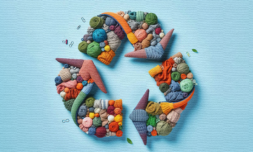What happens to items donated to Trashie?
Once the brightly coloured Take Back Bags arrive back at Trashie, the textiles are then sorted by hand.
Acceptable donations can be anything from clothing to accessories, sheets, or towels, as long as they aren’t soiled by biohazards or dirt which make them impossible to recycle.
Workers at Trashie’s recycling facility will go through each item individually, inspecting pieces and sorting them into 253 different categories based on their fabric composition, condition, and more.
The weight of each item is noted, with each piece tracked to its destination. On average, more than 90 percent of the items received are kept away from landfill.
Trashie’s CEO Kristy Caylor explains that there are multiple paths a garment could take after being inspected. Some items are reused, upcycled, or turned into new yarn. Others are turned into materials for carpet padding, car insulation, or used to make rags for cleaning.
Donators can then claim their $30 in TrashieCash through Trashie’s website and use it on gift cards and discounts including for movie tickets, food delivery, or products from sustainable clothing brands.

Why donation schemes are so important
Every year, the fashion industry generates 120 billion new items of clothing. Fast fashion brands are only expected to grow in their contribution to this figure, with a current market growth rate of 14 percent per year.
Projections suggest the fast fashion industry will be worth $89.99 billion by 2029, up from $46.74 billion in 2024. That means this sector will almost double its worth (and output) in the next five years, which is concerning for the health of our planet and us humans.
With most items from these brands lasting only a couple wears before they fall apart and become unwearable, consumers are quick to throw them into the bin. These items don’t just disappear, however. They’re often sent to poorer nations to pile up in landfill, polluting the surrounding environment.
Taking steps to create a circular economy is paramount. Doing so involves passing on clothing that is still wearable to those who need it, while transforming unsalvageable pieces into new fabrics and innovative materials when possible.
Trashie is doing its part by working to bring the circular fashion economy alive, while literally rewarding customers for participating in their change-focused initiative. With more systems like this one in place, the future of the industry will be far more ethical.






















